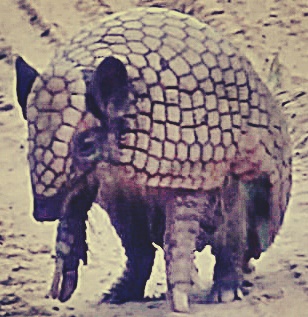
The armadillo with its protective turtle-like shell may appear to be a slow and clumsy creature. It is however in fact quite athletic and can run, dig, and swim. They use their snout and long tongue to dig the ground for food. They can hold their breath underwater for more than 5 minutes. It is a simple and less intelligent animal.
The animal is not really beneficial for the environment, but they also do not cause any damage when living in the wild. One of the main issues with the armadillo is that it tends to enter our yards and houses and digs it up in search of food.

Do Armadillos Bite?
Armadillos do not bite humans, dogs or any pets. They have very small mouths with teeth that are peg like. Even though the run in a hopping manner, they typically do not chase humans with the intention of biting them. It is however very important to be careful when near an armadillo as it is a carrier of diseases like leprosy, salmonella germs, tapeworms, etc.
Anatomy of the armadillo
The big armor-like plates are in reality solid thick scales covering the bigger scutes which guard the animal. All the plates are linked and kept in position by its thick tough skin. The plates cover the sides, back, tail, head, and the outer legs, thereby offer efficient protection against attacks by predators. The teeth of most predators cannot breach this protective shell. The weak points of the armadillo consist of the areas where the scutes connect to the skin and the inside of the legs and the underbelly which do not have the scaly thick shell protection.
The armadillo by its very nature tends to dig and burrow. Like most animals that dig, it also has strong legs featuring powerful claws which can dig at great speeds. Whilst digging, it throws out lots of dirt into a pile behind it. In addition to digging for food, the animal also makes a burrow to live and take care of its young ones. Such burrowed homes are typically shallow, around 2 to 4 feet deep, thereby allowing it an easy escape route in case of danger.
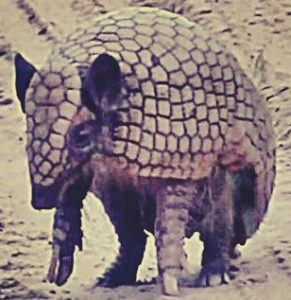
The habitat of armadillos
The armadillo likes to live in shady areas with dense growth and bush, forests, or woodlands with ready availability of water. They generally dig for different kinds of food and hence like places with loose or sandy soil. They may dig near stumps of old trees, piles of bushes, or into mud near rocks. In human inhabited areas, the animal will search for areas that are just like their preferred habitat. They may dig under the house, shed, deck, or porch. They may also search open areas under the house or hide under a woodpile. The strong and sharp claws can be used to easily dig a hole into any opening that may be present in the foundation and thus gain entry under your property.
The armadillo is a nocturnal animal and tends to dig and search for food mostly at night. They tend to sleep through the day in their burrowed home. In most cases, they prefer one burrow as their home. Sometimes, they may come out during the day, typically after a rainstorm or during cooler climatic conditions when earthworms are available in plenty.
Armadillos are not native to North America. They used to live in the moist and dense forests that used to be present in South America. Different and vast environmental changes in South America caused the species to North America. Since there was no natural predator for the armadillo in this new continent, the species have continued to grow and thrive, with increasing population each year.
The armadillos present in North America are known as Nine-Banded armadillos due to the presence of a definite number of bands or segments present on their back. These bands offer easy maneuverability, flexibility, and running capacity to the animal.
Armadillo – Pictures
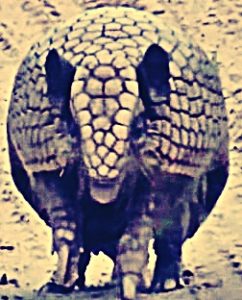
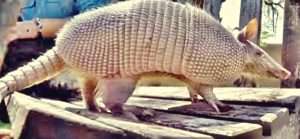
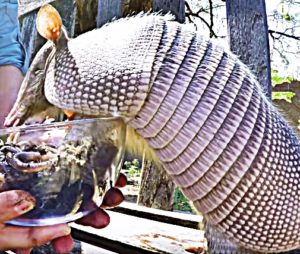
What do armadillos eat?
The animal usually lives off beetle larvae and earthworms, and other insects on occasions. They sniff at the ground and use their super sense of smell to find their food. After it detects food some inches under the ground, they use their claws to quickly dig, then insert their snout into the new hole, and later use their tongue to lick out the food.
What diseases do armadillos carry?
The armadillo is linked to a number of pathogens and diseases, as listed below:
- Leprosy: Studies have shown a strong association with the armadillo and the transmission of leprosy to humans. The armadillo is one of the few animals with body temperature low enough for the disease carrying germ to survive. Humans cannot contract leprosy just due to close proximity with the animal. It can transmit to humans in case they get attacked by the claws of the armadillo, or some other form of close contact, or eating armadillo meat.
- Salmonella bacteria: A variety of animals host the salmonella bacteria and the armadillo is no different. The bacteria can pass to humans via intake of water or food contaminated by the animal. Salmonella infection causes vomiting and diarrhea in adults, but it can have deadly outcome in the elderly, children, and those with compromised immune systems.
- Rabies: Only some kinds of armadillos are known to be carriers of the rabies virus. It can transmit to humans via an armadillo bite or scratch. Avoid armadillos that aren’t naturally shy and/or are increasing active during daytime as they can be possible carriers of rabies.
- Tapeworms: Armadillos are carriers of tapeworm parasite. Tapeworms in the form of eggs may pass to pets and humans after exposure to armadillo feces. Tapeworm eggs pass into the intestine of pets and humans, hatch, grow and cause different intestinal issues. The infected person or pet may then eliminate tapeworm eggs in its feces and thus become a carrier of tapeworms.
Why get rid of the armadillo?
It is important for people to remove armadillos from their property and relocate them elsewhere. The armadillo is classified as a pest due to the below mentioned reasons:
- It burrows small holes in the garden and yard and destroys its beauty, the landscaping, etc.
- It burrows big tunnels under the house thereby damaging the foundation and structural integrity of the house. This can lead to significant repair costs.
- Burrowing can cause significant damage to the pipes. In case it burrows under some vulnerable part of your house like the fuel tank or the ac unit, then it can cause it to collapse, leading to considerable damage to the house.
- The armadillo is a noisy creature. It may rub its shell against the wall and cause you to wake up. They squeal/scream really loudly when threatened. They tend to make grunting noises when eating.
- Burrowing can lead to development of cracks in tiled pathways and concrete
- The animal has a smelly odor which can enter into the house from down below. Sometimes, it may not be able to come out of its burrow and die there. Its carcass can create a really unbearable stench and cause nausea and headaches.
- The armadillo can alarm pets and children
It is best to contact a professional to remove the pest from your property. In case you want to remove the animal and relocate it on your own, then you must first ensure the laws in your state about wildlife trapping. It may be illegal to trap wildlife like armadillos in some states.
How to trap an armadillo?
- Buy an armadillo trap, place some armadillo food in it, and place it on a path that the armadillo may take in your yard/lawn. Do not set the trap for the first few occasions.
- Once the armadillo is familiar with the trap and it being a source of food, you may set it and wait. Once the armadillo is trapped, take it to an isolated place and set it free.
Take all precautions to avoid contact with the animal so as to prevent the transmission of diseases.
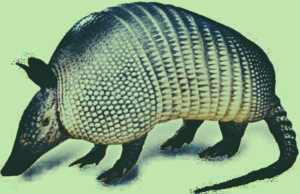
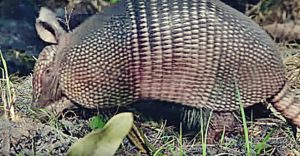
Leave a Reply